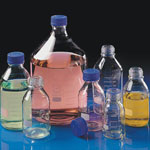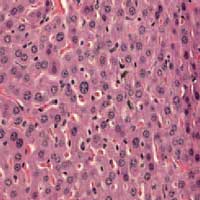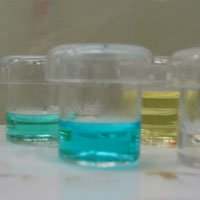Showing Spotlights 89 - 96 of 137 in category All (newest first):
 Synthesized carbon nanotubes, especially single-walled carbon nanotubes (SWCNTs), are in the form of bundles with other impurities such as catalyst particles and amorphous carbon debris. In order to be useful for many types of applications, for instance in nanoelectronic devices or biomedical applications, SWCNTs need to be purified and dispersed into individual nanotubes. One method to do this is by surfactant stabilization of the hydrophobic nanotube surface, which overcomes the van der Waals forces among the nanotubes and results in suspensions of individual SWCNTs. Researchers have now investigated the cytotoxicity of SWCNTs suspended in various surfactants. Their experimental results show that the conjugates SDS/CNT and SDBS/CNT are toxic to astrocytoma cells due solely to the toxicity of the SDS and SDBS molecules, which administered alone are toxic to the cells even at a low concentration of 0.05 mg per ml within 30 min. However, the proliferation and viability of the astrocytoma cells were not affected by SWCNTs and the conjugates SC/CNT and DNA/CNT.
Synthesized carbon nanotubes, especially single-walled carbon nanotubes (SWCNTs), are in the form of bundles with other impurities such as catalyst particles and amorphous carbon debris. In order to be useful for many types of applications, for instance in nanoelectronic devices or biomedical applications, SWCNTs need to be purified and dispersed into individual nanotubes. One method to do this is by surfactant stabilization of the hydrophobic nanotube surface, which overcomes the van der Waals forces among the nanotubes and results in suspensions of individual SWCNTs. Researchers have now investigated the cytotoxicity of SWCNTs suspended in various surfactants. Their experimental results show that the conjugates SDS/CNT and SDBS/CNT are toxic to astrocytoma cells due solely to the toxicity of the SDS and SDBS molecules, which administered alone are toxic to the cells even at a low concentration of 0.05 mg per ml within 30 min. However, the proliferation and viability of the astrocytoma cells were not affected by SWCNTs and the conjugates SC/CNT and DNA/CNT.
May 19th, 2008
 The controversy over the use of nanoparticles in everyday products, such as cosmetics, has been going on for a while now. At best, the evidence is inconclusive - it's too early to say whether there is a risk or not. The cosmetics industry of course argues that their nanoparticle-containing products are perfectly safe because no problem has been reported so far. Consumer, health and environmental groups beg to differ and claim that there is a potential risk because we just don't know enough about this issue and that we rather should err on the side of caution. The fact is, as a recent report by the European Commission's Health and Consumer Protectorate states, that at present there is inadequate information on hazard identification, exposure assessment, uptake, the role of physico-chemical parameters of nanoparticles determining absorption and transport across membranes in the gut and lungs, the role of physico-chemical parameters of nanoparticles in systemic circulation determining biokinetics and accumulation in secondary target organs, possible health effects, and translocation of nanoparticles via the placenta to the foetus. The EU report concludes that conventional risk assessment methodologies may be adequate for products that contain soluble and/or biodegradable nanoparticles but not for insoluble and/or biopersistent nanoparticles.
The controversy over the use of nanoparticles in everyday products, such as cosmetics, has been going on for a while now. At best, the evidence is inconclusive - it's too early to say whether there is a risk or not. The cosmetics industry of course argues that their nanoparticle-containing products are perfectly safe because no problem has been reported so far. Consumer, health and environmental groups beg to differ and claim that there is a potential risk because we just don't know enough about this issue and that we rather should err on the side of caution. The fact is, as a recent report by the European Commission's Health and Consumer Protectorate states, that at present there is inadequate information on hazard identification, exposure assessment, uptake, the role of physico-chemical parameters of nanoparticles determining absorption and transport across membranes in the gut and lungs, the role of physico-chemical parameters of nanoparticles in systemic circulation determining biokinetics and accumulation in secondary target organs, possible health effects, and translocation of nanoparticles via the placenta to the foetus. The EU report concludes that conventional risk assessment methodologies may be adequate for products that contain soluble and/or biodegradable nanoparticles but not for insoluble and/or biopersistent nanoparticles.
May 5th, 2008
 The toxicity issues surrounding carbon nanotubes (CNTs) are highly relevant for two reasons: Firstly, as more and more products containing CNTs come to market, there is a chance that free CNTs get released during their life cycles, most likely during production or disposal, and find their way through the environment into the body. Secondly, and much more pertinent with regard to potential health risks, is the use of CNTs in biological and medical settings. CNTs interesting structural, chemical, electrical, and optical properties are explored by numerous research groups around the world with the goal of drastically improving performance and efficacy of biological detection, imaging, and therapy applications. In many of these envisaged applications, CNTs would be deliberately injected or implanted in the body. For instance, CNT-based intercellular molecular delivery vehicles have been developed for intracellular gene and drug delivery in vitro. What these CNTs do once inside the body and after they discharge their medical payloads is not well understood. Cell culture studies have shown evidence of cytotoxicity and oxidative stress induced by single-walled carbon nanotubes (SWCNTs), depending on whether and to what degree they are functionalized or oxidized. A new study at Stanford University tested non-covalently pegylated SWCNTs as a 'least toxic scenario', and oxidized, covalently functionalized nanotubes as a 'most toxic scenario' in a study on mice. It was found that SWCNTs injected intravenously into nude mice do not appear to have any significant toxicity during an observation period of four months following injection.
The toxicity issues surrounding carbon nanotubes (CNTs) are highly relevant for two reasons: Firstly, as more and more products containing CNTs come to market, there is a chance that free CNTs get released during their life cycles, most likely during production or disposal, and find their way through the environment into the body. Secondly, and much more pertinent with regard to potential health risks, is the use of CNTs in biological and medical settings. CNTs interesting structural, chemical, electrical, and optical properties are explored by numerous research groups around the world with the goal of drastically improving performance and efficacy of biological detection, imaging, and therapy applications. In many of these envisaged applications, CNTs would be deliberately injected or implanted in the body. For instance, CNT-based intercellular molecular delivery vehicles have been developed for intracellular gene and drug delivery in vitro. What these CNTs do once inside the body and after they discharge their medical payloads is not well understood. Cell culture studies have shown evidence of cytotoxicity and oxidative stress induced by single-walled carbon nanotubes (SWCNTs), depending on whether and to what degree they are functionalized or oxidized. A new study at Stanford University tested non-covalently pegylated SWCNTs as a 'least toxic scenario', and oxidized, covalently functionalized nanotubes as a 'most toxic scenario' in a study on mice. It was found that SWCNTs injected intravenously into nude mice do not appear to have any significant toxicity during an observation period of four months following injection.
Apr 22nd, 2008
 Following just two days after we wrote about the food industry's deafening silence on their nanotechnology research and development, the Investor Environmental Health Network today released a report that demonstrates that sectors affected by product toxicity risks are doing a poor job of informing shareholders of market risks they face due to toxic chemicals in their products. The report specifically addresses the situation for companies dealing with nanomaterials by noting that manufacturers are not disclosing the evidence of health risks of nanotechnology products, nor the lack of adequate product testing prior to their sales. An interesting observation is that some nanomaterial manufacturers are more open to communicating potential uncertainties than their customers. These customers of the nanomaterials are the manufacturers of an array of products from electronics to food and cosmetics - and they tend not to disclose the potential health and financial risks. IEHN's conclusion is that investors should be apprised of the state of the science by a company, instead of being misled to believe that the serious questions have been answered.
Following just two days after we wrote about the food industry's deafening silence on their nanotechnology research and development, the Investor Environmental Health Network today released a report that demonstrates that sectors affected by product toxicity risks are doing a poor job of informing shareholders of market risks they face due to toxic chemicals in their products. The report specifically addresses the situation for companies dealing with nanomaterials by noting that manufacturers are not disclosing the evidence of health risks of nanotechnology products, nor the lack of adequate product testing prior to their sales. An interesting observation is that some nanomaterial manufacturers are more open to communicating potential uncertainties than their customers. These customers of the nanomaterials are the manufacturers of an array of products from electronics to food and cosmetics - and they tend not to disclose the potential health and financial risks. IEHN's conclusion is that investors should be apprised of the state of the science by a company, instead of being misled to believe that the serious questions have been answered.
Apr 18th, 2008
 Despite their name, carbon nanotubes (CNTs) are not made of 100% carbon. Depending on which of the various synthesis techniques is used in their production, CNTs have variable chemistries and physical properties resulting from their different metal catalysts or amorphous carbon coatings. As a result, they may contain large percentages of metal and carbonaceous impurities which will have different environmental and toxicological impacts. In early toxicological studies, researchers obtained confounding results - in some studies nanotubes were toxic; in others, they were not. The apparent contradictions were actually a result of the materials that the researchers were using, not appreciating that 'carbon nanotubes' are really 'carbon nanotubes + metal + amorphous impurities'. Ignoring these impurities prohibits scientists from fully understanding the material's electronic character, environmental transport, transformation, and ecotoxicology. To address these needs, a group of researchers measured the elemental, molecular, and stable carbon isotope compositions of commercially available single-walled carbon nanotubes (SWCNTs) produced by ten companies in the United States, giving a true picture of their diversity and chemical complexity. This diversity and complexity is extremely important from both fate and toxicity perspectives.
Despite their name, carbon nanotubes (CNTs) are not made of 100% carbon. Depending on which of the various synthesis techniques is used in their production, CNTs have variable chemistries and physical properties resulting from their different metal catalysts or amorphous carbon coatings. As a result, they may contain large percentages of metal and carbonaceous impurities which will have different environmental and toxicological impacts. In early toxicological studies, researchers obtained confounding results - in some studies nanotubes were toxic; in others, they were not. The apparent contradictions were actually a result of the materials that the researchers were using, not appreciating that 'carbon nanotubes' are really 'carbon nanotubes + metal + amorphous impurities'. Ignoring these impurities prohibits scientists from fully understanding the material's electronic character, environmental transport, transformation, and ecotoxicology. To address these needs, a group of researchers measured the elemental, molecular, and stable carbon isotope compositions of commercially available single-walled carbon nanotubes (SWCNTs) produced by ten companies in the United States, giving a true picture of their diversity and chemical complexity. This diversity and complexity is extremely important from both fate and toxicity perspectives.
Apr 10th, 2008
 Notwithstanding the mixed news (to put it mildly) that individual investors have been getting from their nanotechnology stock portfolios, industry as a whole is pressing ahead with incorporating nanotechnologies in their products and processes. Unlike many other areas of science, nanosciences are capable of influencing a wide sweep of industrial and medical processes, from cleaner energy applications, to smart materials and revolutionary medical applications. It is increasingly difficult to know which products use nanotechnology or incorporate nanomaterials; nanotechnology consumer product directories give an idea where nanomaterials are used but are increasingly useless in helping to understand the full extent of nanotechnologies penetrating industrial manufacturing processes. Some consumer companies embrace 'nano' wholeheartedly and advertise their 'revolutionary' face creams, tennis rackets and car waxes; some, after increased scrutiny, have become very quiet about their nanotechnology activities (especially the large cosmetics and food companies); and some even change their company name to something that doesn't include 'nano' ('cleantech' or 'greentech' has become the new nanotech). Combine this technological shift that is taking place in industries across the board with the still existing lack of conclusive answers about the toxicity of nanomaterials, and you get a worrisome mix of industry pushing ahead unconstrained, a regulatory environment where key constituencies are ill prepared and underfunded to address the issues with the speed required, and public opinion that covers the whole range from activists calling for a complete moratorium on all things nano to snake-oil salesmen who promise nanotechnology stock tips that will make you a gazillionaire. Oh, and apparently now you can also add to this mix certain religious types in the U.S. who find nanotechnology is morally not acceptable.
Notwithstanding the mixed news (to put it mildly) that individual investors have been getting from their nanotechnology stock portfolios, industry as a whole is pressing ahead with incorporating nanotechnologies in their products and processes. Unlike many other areas of science, nanosciences are capable of influencing a wide sweep of industrial and medical processes, from cleaner energy applications, to smart materials and revolutionary medical applications. It is increasingly difficult to know which products use nanotechnology or incorporate nanomaterials; nanotechnology consumer product directories give an idea where nanomaterials are used but are increasingly useless in helping to understand the full extent of nanotechnologies penetrating industrial manufacturing processes. Some consumer companies embrace 'nano' wholeheartedly and advertise their 'revolutionary' face creams, tennis rackets and car waxes; some, after increased scrutiny, have become very quiet about their nanotechnology activities (especially the large cosmetics and food companies); and some even change their company name to something that doesn't include 'nano' ('cleantech' or 'greentech' has become the new nanotech). Combine this technological shift that is taking place in industries across the board with the still existing lack of conclusive answers about the toxicity of nanomaterials, and you get a worrisome mix of industry pushing ahead unconstrained, a regulatory environment where key constituencies are ill prepared and underfunded to address the issues with the speed required, and public opinion that covers the whole range from activists calling for a complete moratorium on all things nano to snake-oil salesmen who promise nanotechnology stock tips that will make you a gazillionaire. Oh, and apparently now you can also add to this mix certain religious types in the U.S. who find nanotechnology is morally not acceptable.
Mar 12th, 2008
 Over the last decade, the European Union (EU) has established a strong knowledge base in nanosciences and developed significant research and development capabilities in nanotechnology. In accordance with the Treaty of the EU, applications of nanotechnology need to comply with the requirements for a high level of public health, safety, consumer and environmental protection (Treaty articles require that a 'high level of human health protection [...] be ensured in the definition and implementation of all Community policies and activities' and that 'consumer protection requirements [...] be taken into account in defining and implementing other Community policies and activities'). Through its Framework Programs (FP), Europe's strategy has been and is to support the safe, responsible development of nanotechnology while providing favourable conditions for industrial innovation. Following this commitment of addressing upfront the potential risks, the European Commission has boosted support for specific collaborative research into the potential impact of nanoparticles on human health and the environment since the Framework Programme 5 (FP5) which started in 1999. These activities have been continued and reinforced in FP6 and in FP7 where several topics were launched specifically addressing the safety of nanomaterials. At the same time, the EU Members States have also been funding research in that field, but a consolidated overview of these ongoing or finished projects was not yet available so the magnitude of these national efforts was difficult to evaluate. The EU now has released a report that lists all nanotechnology research funding in the Community that address in particular the health and environmental impact of nanoparticles.
Over the last decade, the European Union (EU) has established a strong knowledge base in nanosciences and developed significant research and development capabilities in nanotechnology. In accordance with the Treaty of the EU, applications of nanotechnology need to comply with the requirements for a high level of public health, safety, consumer and environmental protection (Treaty articles require that a 'high level of human health protection [...] be ensured in the definition and implementation of all Community policies and activities' and that 'consumer protection requirements [...] be taken into account in defining and implementing other Community policies and activities'). Through its Framework Programs (FP), Europe's strategy has been and is to support the safe, responsible development of nanotechnology while providing favourable conditions for industrial innovation. Following this commitment of addressing upfront the potential risks, the European Commission has boosted support for specific collaborative research into the potential impact of nanoparticles on human health and the environment since the Framework Programme 5 (FP5) which started in 1999. These activities have been continued and reinforced in FP6 and in FP7 where several topics were launched specifically addressing the safety of nanomaterials. At the same time, the EU Members States have also been funding research in that field, but a consolidated overview of these ongoing or finished projects was not yet available so the magnitude of these national efforts was difficult to evaluate. The EU now has released a report that lists all nanotechnology research funding in the Community that address in particular the health and environmental impact of nanoparticles.
Feb 12th, 2008
 More and more carbon nanotube (CNT) applications are moving from the research lab into commercial products. For example, CNTs can be found already in tennis rackets and bicycles, displays and TV screens, and numerous resins used by aerospace, defense, health care, and electronics companies. Not surprisingly, CNT production is growing by hundreds of metric tons a year. One of the large suppliers alone, Bayer, is talking about having 3,000 metric tons of production capacity in place by 2012. As a result of the increasing supply, prices are dropping fast. While a kilogram of multi-walled CNTs (MWCNTs) sold for tens of thousands of dollars just a few years ago (and single-walled CNTs still do), the price for some types of MWCNTs has fallen to hundreds of dollars per kg. Recent market analyses forecast sales of all nanotubes to reach $1 billion to $2 billion annually within the next four to seven years. In terms of dollar value, electronics devices will be the largest end-use category, although composite materials in automotive applications may account for greater volumes. These volumes are expected to approach several thousand metric tons per year. This means that the exposure to CNTs, especially by factory workers, will increase substantially over the next few years. Since the jury is still out as to the toxicity of nanotubes it appears prudent to at least develop suitable sensor technology to detect CNTs, especially in the workplace.
More and more carbon nanotube (CNT) applications are moving from the research lab into commercial products. For example, CNTs can be found already in tennis rackets and bicycles, displays and TV screens, and numerous resins used by aerospace, defense, health care, and electronics companies. Not surprisingly, CNT production is growing by hundreds of metric tons a year. One of the large suppliers alone, Bayer, is talking about having 3,000 metric tons of production capacity in place by 2012. As a result of the increasing supply, prices are dropping fast. While a kilogram of multi-walled CNTs (MWCNTs) sold for tens of thousands of dollars just a few years ago (and single-walled CNTs still do), the price for some types of MWCNTs has fallen to hundreds of dollars per kg. Recent market analyses forecast sales of all nanotubes to reach $1 billion to $2 billion annually within the next four to seven years. In terms of dollar value, electronics devices will be the largest end-use category, although composite materials in automotive applications may account for greater volumes. These volumes are expected to approach several thousand metric tons per year. This means that the exposure to CNTs, especially by factory workers, will increase substantially over the next few years. Since the jury is still out as to the toxicity of nanotubes it appears prudent to at least develop suitable sensor technology to detect CNTs, especially in the workplace.
Feb 4th, 2008
 Synthesized carbon nanotubes, especially single-walled carbon nanotubes (SWCNTs), are in the form of bundles with other impurities such as catalyst particles and amorphous carbon debris. In order to be useful for many types of applications, for instance in nanoelectronic devices or biomedical applications, SWCNTs need to be purified and dispersed into individual nanotubes. One method to do this is by surfactant stabilization of the hydrophobic nanotube surface, which overcomes the van der Waals forces among the nanotubes and results in suspensions of individual SWCNTs. Researchers have now investigated the cytotoxicity of SWCNTs suspended in various surfactants. Their experimental results show that the conjugates SDS/CNT and SDBS/CNT are toxic to astrocytoma cells due solely to the toxicity of the SDS and SDBS molecules, which administered alone are toxic to the cells even at a low concentration of 0.05 mg per ml within 30 min. However, the proliferation and viability of the astrocytoma cells were not affected by SWCNTs and the conjugates SC/CNT and DNA/CNT.
Synthesized carbon nanotubes, especially single-walled carbon nanotubes (SWCNTs), are in the form of bundles with other impurities such as catalyst particles and amorphous carbon debris. In order to be useful for many types of applications, for instance in nanoelectronic devices or biomedical applications, SWCNTs need to be purified and dispersed into individual nanotubes. One method to do this is by surfactant stabilization of the hydrophobic nanotube surface, which overcomes the van der Waals forces among the nanotubes and results in suspensions of individual SWCNTs. Researchers have now investigated the cytotoxicity of SWCNTs suspended in various surfactants. Their experimental results show that the conjugates SDS/CNT and SDBS/CNT are toxic to astrocytoma cells due solely to the toxicity of the SDS and SDBS molecules, which administered alone are toxic to the cells even at a low concentration of 0.05 mg per ml within 30 min. However, the proliferation and viability of the astrocytoma cells were not affected by SWCNTs and the conjugates SC/CNT and DNA/CNT.
 Subscribe to our Nanotechnology Spotlight feed
Subscribe to our Nanotechnology Spotlight feed





